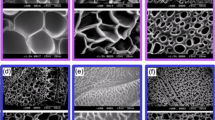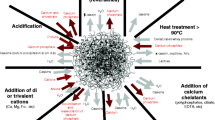Abstract
Methylcellulose (MC) and kappa carrageenan (KCG) are widely used in food and pharmaceutical industries as a viscosity modifier, a gelling aid, and a film former due to their reversible thermal gelation properties. Thermoreversible gelation of MC/salt, MC/KCG/water, and MC/KCG/salt mixtures was investigated utilizing dynamic and steady shear rheological measurements. It was found that for the MC/salt mixture, gelation temperatures decreased linearly with increasing salt concentrations independent of valences of cations and molar concentrations of anions. For the MC/KCG blend, double gelation was not observed, and KCG is not influenced or disturbed the gelation properties of MC. Double gelation was observed for the mixture of MC/KCG/KCl for the low concentration of salts of 0.01 M KCl and 0.04 M KCl with the maximum moduli values for the mixture of MC/KCG/0.04 M KCl and then gradually decreased with increasing KCl salt concentration and eventually became similar to the gelation of MC solution. Therefore, KCl concentration played a major role in double gelation properties of MC/KCG/KCl mixture. It was also found that for the MC/KCG/KCl system, gelation transition matrices are linearly depending on salt concentration and independent of KCG and salt type. It was shown that for MC/salt mixture, solution rheology follows the principle of time–temperature superposition (TTS) below the gelation temperature. However, TTS failed above the gelation temperature. TTS also failed for MC/KCG and MC/KCG with low KCl concentration mixtures.












Similar content being viewed by others
References
Kumar V, Banker GS (1993) Chemically-modified cellulosic polymers. Drug Dev Ind Pharm 19(1–2):1–30
Lin SY, Wang SL, Wei YS, Li MJ (2007) Temperature effect on water desorption from methylcellulose films studied by thermal FT-IR micro spectroscopy. Surf Sci 601:781–785
Perez OE, Sanchez CC, Pilosof AM, Patino JM (2008) Dynamics of adsorption of hydroxypropyl methylcellulose at the air–water interface. Food Hydrocoll 22:387–402
Hoffman AS (2002) Hydrogels for biomedical applications. Adv Drug Deliv Rev 54:3–12
Chen CH, Tsai CC, Chen W, Mi FL, Liang HF, Chen SC, Sung HW (2006) Novel living cell sheet harvest system composed of thermoreversible methylcellulose hydrogels. Biomacromolecules 7(3):736–743
Guiseley KB, Stanley N, Whitehouse P (1980) chapter 5. In: Davidson R (ed) Industrial gums. McGraw-Hill, New York
Piculell L (2006) Gelling carrageenans. In: Stephen AM, Phillips GO, Williams PA (eds) Food polysaccharides and their applications. CRC Press, Boca raton
Haque A, Morris ER (1993) Thermogelation of methylcellulose. Part I: molecular structures and processes. Polymer 22(3):161–173
Rotbaum Y, Parvari G, Eichen Y, Rittel D (2017) Static and dynamic large strain properties of methyl cellulose hydrogels. Macromolecules 50(12):4817–4826
Kobayashi K, Huang C, Lodge TP (1999) Thermoreversible gelation of aqueous methylcellulose solutions. Macromolecules 32:7070–7077
Li L, Shan H, Yue CY, Lam YC, Tam KC, Hu X (2002) Thermally induced association and dissociation of methylcellulose in aqueous solutions. Langmuir 18:7291–7298
Haque A, Richardson RK, Morris ER, Gidley MJ, Caswell DC (1993) Thermogelation of methylcellulose. Part II: effect of hydroxypropyl substituents. Carbohydr Polym 22(3):175–186
Lam YC, Joshi SC, Tan BK (2007) Thermodynamic characteristics of gelation for methyl-cellulose hydrogels. J Therm Anal Calorim 87(2):475–482
Ford JL (1999) Thermal analysis of hydroxypropylmethylcellulose and methylcellulose: powders, gels and matrix tablets. Int J Pharm 179(2):209–228
Almeida N, Rakesh L, Zhao J (2014) Monovalent and divalent salt effects on thermogelation of aqueous hypromellose solutions. Food Hydrocoll 36:323–331
Almeida N, Rakesh L, Zhao J (2014) Phase behavior of concentrated hydroxypropyl methylcellulose solution in the presence of mono and divalent salt. Carbohydr Polym 99:630–637
Carlssona A, Karlströmb G, Lindman B (1990) Thermal gelation of nonionic cellulose ethers and ionic surfactants in water. Colloids Surf 47:147–165
Ibbett RN, Philp K, Price DM (1992) 13C n.m.r. studies of the thermal behaviour of aqueous solutions of cellulose ethers. Polymer 33(19):4087–4095
Kobayashi K, Huang C, Lodge TP (1993) Thermoreversible gelation of aqueous methylcellulose solutions. Macromolecules 32(21):7070–7077
Bodvika R, Dedinaitea A, Karlsonb L, Bergströma M, Bäverbäckc P, Pedersenc JS, Edwardsd K, Karlssond G, Vargaa I, Claessona PM (2010) Aggregation and network formation of aqueous methylcellulose and hydroxypropylmethylcellulose solutions. Colloids Surf A Physicochem Eng Asp 354:162–171
Sekiguchi Y, Sawatari C, Kondo T (2003) A gelation mechanism depending on hydrogen bond formation in regioselectively substituted O-methylcelluloses. Carbohydr Polym 53(2):145–153
Liu SQ, Joshi SC, Lam YC, Tam KC (2008) Thermoreversible gelation of hydroxypropylmethylcellulose in simulated body fluids. Carbohydr Polym 72:133–143
Lott JR, McAllister JW, Arvidson SA, Bates FS, Lodge TP (2013) Fibrillar structure of methylcellulose hydrogels. Biomacromolecules 14(8):2484–2488
Xu Y, Wang C, Tam K, Li L (2004) Salt-assisted and salt-suppressed sol–gel transitions of methylcellulose in water. Langmuir 20(3):646–652
Xu Y, Wang C, Tam KC, Li L (2004) Salt-assisted and salt-suppressed sol–gel transitions of methylcellulose in water. Langmuir 20(3):646–652
Alexandridis P, Holzwarth JF (1997) Differential scanning calorimetry investigation of the effect of salts on aqueous solution properties of an amphiphilic block copolymer (poloxamer). Langmuir 13:6074–6082
Iijima M, Hatakeyama T, Takahashi M, Hatakeyama H (2007) Effect of thermal history on kappa-carrageenan hydrogelation by differential scanning calorimetry. Thermochim Acta 452(1):53–58
Yuguchi Y, Thuy TTT, Urakawa H, Kajiwara K (2002) Structural characteristics of carrageenan gels: temperature and concentration dependence. Food Hydrocoll 16(6):515–522
Kara S, Arda E, Kavzak B, Pekcan Ö (2006) Phase transitions of κ-carrageenan gels in various types of salts. J Appl Polym Sci 102(3):3008–3016
Kara S, Tamerler C, Bermek H, Pekcan Ö (2003) Cation effects on sol–gel and gel–sol phase transitions of κ-carrageenan-water system. Int J Biol Macromol 31(4):177–185
Arda E, Kara S, Pekcan Ö (2009) Synergistic effect of the locust bean gum on the thermal phase transitions of κ-carrageenan gels. Food Hydrocoll 23(2):451–459
Mangione M, Giacomazza D, Bulone D, Martorana V, San Biagio P (2003) Thermoreversible gelation of κ-Carrageenan: relation between conformational transition and aggregation. Biophys Chem 104(1):95–105
Takemasa M, Chiba A, Date M (2002) Counterion dynamics of κ-and ι-carrageenan aqueous solutions investigated by the dielectric properties. Macromolecules 35(14):5595–5600
Thành TT, Yuguchi Y, Mimura M, Yasunaga H, Takano R, Urakawa H, Kajiwara K (2002) Molecular characteristics and gelling properties of the carrageenan family, 1. Preparation of novel carrageenans and their dilute solution properties. Macromol Chem Phys 203(1):15–23
Ikeda S, Morris VJ, Nishinari K (2001) Microstructure of aggregated and nonaggregated κ-carrageenan helices visualized by atomic force microscopy. Biomacromolecules 2(4):1331–1337
MacArtain P, Jacquier J, Dawson K (2003) Physical characteristics of calcium induced κ-carrageenan networks. Carbohydr Polym 53(4):395–400
Tomšič M, Prossnigg F, Glatter O (2008) A thermoreversible double gel: characterization of a methylcellulose and κ-carrageenan mixed system in water by SAXS, DSC and rheology. J Colloid Interface Sci 322(1):41–50
Ferry JD (1980) Viscoelastic properties of polymers, 3rd edn. Wiley, New Jersey
Macosko CW (1994) Rheology: principles measurements and applications. Wiley-VCH, New Jersey
Liu SQ, Joshi SC, Lam YC (2008) Effects of salts in the hofmeister series and solvent isotopes on the gelation mechanisms for hydroxypropylmethylcellulose hydrogels. J Appl Polym Sci 109:363–372
Thrimawithana TR, Young S, Dunstan DE, Alany RG (2010) Texture and rheological characterization of kappa and iota carrageenan in the presence of counter ions. Carbohydr Polym 82(1):69–77
Desbrieres J, Hirrien M, Ross-Murphy SB (2000) Thermogelation of methylcellulose: rheological considerations. Polymer 41(7):2451–2461
Acknowledgements
Authors are grateful to Dow Pharma and Food Solutions for providing the methylcellulose materials. We also acknowledge the financial support given by The Science of Advanced Materials at Central Michigan University.
Author information
Authors and Affiliations
Corresponding author
Rights and permissions
About this article
Cite this article
Almeida, N., Rakesh, L. & Zhao, J. The effect of kappa carrageenan and salt on thermoreversible gelation of methylcellulose. Polym. Bull. 75, 4227–4243 (2018). https://doi.org/10.1007/s00289-017-2256-z
Received:
Revised:
Accepted:
Published:
Issue Date:
DOI: https://doi.org/10.1007/s00289-017-2256-z




